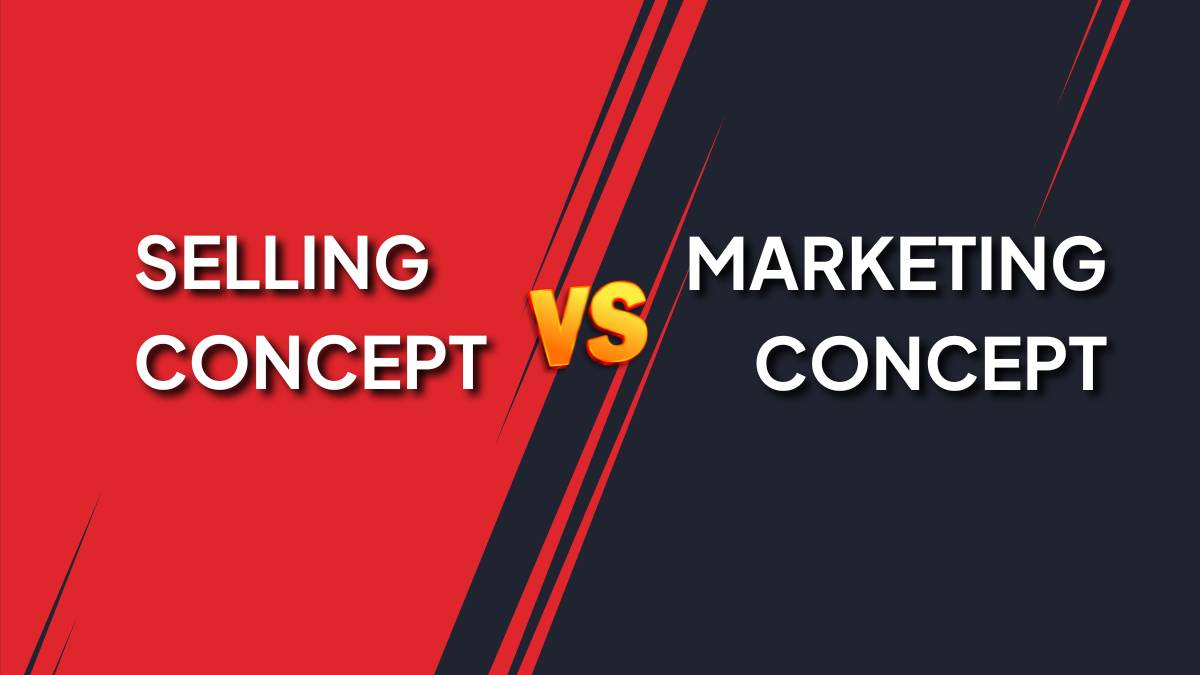Table of Contents
Introduction
If you look at the way businesses have evolved over the years, you’ll notice two very different approaches to how they sell and market their products. On one side, there’s the selling concept, which is all about pushing a product to customers whether they asked for it or not. On the other, there’s the marketing concept, which is centered around finding out what people actually want and then building solutions around that.
It sounds simple when you put it like that, but the difference is huge. And honestly, a lot of businesses still get stuck in the old way of doing things.
In short, Selling Concept vs Marketing Concept:
The selling concept is about selling what the company makes, while the marketing concept is about making what the customer wants.
What is the Selling Concept?
Definition
The selling concept is a business mindset where companies assume customers won’t naturally buy enough on their own, so they need to be persuaded, convinced, or sometimes even pressured into making a purchase. It’s less about the customer’s needs and more about moving the product off the shelves.
Key Features
- Heavy focus on salespeople, advertising, and promotions
- Goal is short-term sales rather than long-term loyalty
- Emphasis on volume and pushing harder than competitors
- Often used where demand is not automatic (insurance, timeshares, etc.)
Advantages of the Selling Concept
- Useful when a company needs to clear inventory quickly
- Works in industries where people don’t actively seek out the product
- Can create urgency and drive sales spikes in the short term
Limitations of the Selling Concept
- Doesn’t prioritize customer satisfaction
- Can come across as pushy, which hurts reputation over time
- Customers may buy once but rarely come back
- Lacks focus on building brand loyalty or community
Example of Selling Concept in Business
Insurance is one of the clearest examples. People don’t usually wake up excited to buy an insurance policy. Companies rely on sales agents, outbound calls, and heavy advertising to convince people. Without those efforts, most of the sales wouldn’t happen at all.
Also Read: What is Societal Marketing Concept?
What is the Marketing Concept?
Definition
The marketing concept is the opposite way of thinking. Instead of creating a product first and then figuring out how to sell it, businesses start by researching customers, what they want, what problems they face, how they behave, and then build products or services designed to meet those needs.
It’s less about pushing and more about aligning.
Key Features
- Customer-first approach
- Long-term focus on relationships and loyalty
- Sees profit as a result of customer satisfaction, not just sales volume
- Relies heavily on market research, segmentation, and customer insights
Advantages of the Marketing Concept
- Builds stronger, lasting relationships with customers
- Creates brand loyalty and repeat business
- Aligns products more closely with what people actually want
- Reduces risk of product failure since it’s based on real needs
Limitations of the Marketing Concept
- Requires more research and investment upfront
- Takes time to develop products around customer insights
- Competitive markets mean customer needs are always shifting, so it’s never “done”
Example of Marketing Concept in Business
Apple is a good example here. The company invests a huge amount into understanding how people use technology and what frustrations they have. Their products, from the iPhone to the Apple Watch, are designed around solving those user needs in a seamless, almost intuitive way. They’re not pushing unwanted products; they’re creating things people line up for.
Also Read: What is Product Concept?
Selling Concept vs Marketing Concept: Key Differences
Here’s a quick side-by-side comparison to make things clearer:
| Aspect | Selling Concept | Marketing Concept |
| Definition | Focuses on selling what the company makes | Focuses on making what the customer wants |
| Core Focus | Product and sales | Customer and needs |
| Business Orientation | Inside-out (company first) | Outside-in (customer first) |
| Goal | Maximize sales volume | Satisfy customers for long-term profit |
| Time Horizon | Short-term | Long-term |
| Approach to Customers | Persuasion, often aggressive | Understanding and serving |
| Role of Promotion | Primary driver of sales | One part of a larger customer strategy |
| Risk Factors | High risk of churn and dissatisfaction | Risk of higher investment and slower payoff |
| Profitability Source | From pushing more sales | From customer satisfaction and loyalty |
| Example Industries | Insurance, door-to-door sales, timeshares | Tech, FMCG, e-commerce, hospitality |

Enroll Now: Advanced Digital Marketing Course
Selling Concept vs Marketing Concept: Which One Should Businesses Use?
- It’s not a clear-cut choice. Selling concept isn’t completely outdated, it still has its uses.
- Works well for products people rarely seek out (life insurance, timeshares, funeral plans, etc.). Without pushy selling, demand wouldn’t exist.
- Seasonal retail often relies on it too (e.g., stores discounting winter jackets in March to clear shelves).
- Marketing concept, however, dominates today. Customers are informed, picky, and research everything before buying.
- Brands like Amazon and Netflix win because they anticipate needs instead of forcing products on people.
- The best approach? A balance. Use marketing concept as the core strategy but bring in selling tactics when urgency is needed.
Also Read: Difference Between Selling and Marketing
Selling Concept and Marketing Concept in the Marketing Mix
Now, if we zoom into the marketing mix (product, price, place, promotion), you’ll notice the approach shifts completely depending on which philosophy a business follows.
- Product: In selling, the company makes what it knows how to make and then tries to sell it. In marketing, you do research first, figure out what people are asking for, then design around that.
- Price: Selling often pushes cost-based pricing with discounts to drive sales. Marketing concept uses value-based pricing, charge based on what it’s worth to the customer.
- Promotion: Selling = aggressive ads, door-to-door, telemarketing, “buy now” pressure. Marketing = storytelling, education, social content, community building.
- Place (distribution): Selling spreads product everywhere possible, just to maximize reach. Marketing focuses on being present in the right places, where customers actually prefer to buy.
The contrast is pretty clear. One is company-first, the other is customer-first.
Also Read: Modern Marketing Concepts
Conclusion
While the selling concept still has a role, especially for products that don’t naturally create demand, the marketing concept is where most businesses should place their bets today. Customers expect brands to listen, to solve real problems, and to give them reasons to stay loyal. That doesn’t mean you never use selling, it can be powerful when stock needs to move fast or during a big launch. But the foundation should be customer-first. Think of it as building trust and relationships rather than just chasing transactions. In the long run, businesses that align themselves with their customers’ needs will not only make sales but also create loyalty that keeps paying back.
FAQs: Selling Concept vs Marketing Concept
What’s the main difference?
Selling is about pushing what you’ve made. Marketing is about making what people actually want.
Which is more customer-friendly?
Definitely the marketing concept. The selling concept often ignores whether the customer really benefits, as long as the sale happens.
Why is the marketing concept stronger today?
Because customers have choices, and they’re not easy to fool. With reviews, social media, and endless options, people won’t tolerate being pushed into something that doesn’t fit.
Can businesses use both at the same time?
Yes, and many do. The strategy might be marketing-led, but selling tactics still come into play when there’s urgency, like end-of-season stock or a product launch.
Who’s a good example of the marketing concept?
Starbucks. They don’t just sell coffee; they created a “third place” between home and work. The whole experience, the customization, the cozy vibe, the consistency, is built around customer wants, not just moving cups of coffee.

